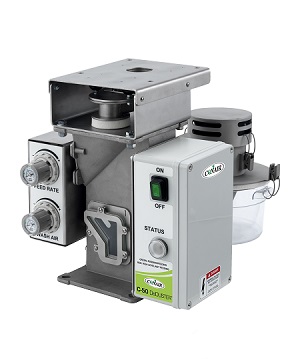In a major redesign of the patented DeDuster® C-50 separator, Conair has simplified operation, eliminated wear-prone moving parts, and improved processing of regrind, which can be very dusty. The system, which nominally processes up to 50 lb/hr (22.5 kg/hr), is able to remove lightweight dust, angel hair and streamers from otherwise high-quality pelletised feedstock and regrind being fed to plastics processing machines. If not removed, dust and other lightweight fractions can cause cosmetic problems in moulded or extruded products, including haziness, gels and black spots, as well as mechanical flaws and housekeeping problems.
The new C-50 Mini-DeDuster will be featured as part of The Conair Summit, a virtual event launching May 18th in lieu of the cancelled NPE 2021 tradeshow.
Major design improvements include an adjustable, pneumatically driven vibratory feeder that replaces a paddle-style metering device, which was prone to wear, and which had occasional problems feeding regrind. With the vibratory feeder, regrind flows smoothly and there are no moving parts in contact with the material and, thus, no chance of wear. The feed rate is adjusted via a knob that regulates pneumatic pressure driving the vibrating tray.
Designers also created a wider opening through which solids flow inside of the DeDuster. The previous smaller opening was prone to bridging with regrind particles even as small as ¼ inch (6.4 mm). Now, with the larger opening, the DeDuster can typically process regrinds up to 3/8 inch (9.5 mm).
The other enhancement is a built-in level sensor that shuts off the feeder when the hopper below is nearly full. This is important because the DeDuster cannot operate in a flood-feed condition. With the previous generation of the product, users needed to know the precise volume of the hopper and demand of the processing machine and then manually adjust feed rates to prevent over-filling.

The Conair DeDuster C50 commonly achieves residual dust content of <50 ppm for fines smaller than 500 micron and 100% streamer removal. It is extremely lightweight, weighing just 40 lbs (18.2 kg) and requires only 13.25 inches (337 mm) of additional headroom above the feedthroat of the moulding machine or extruder and loading or drying hoppers. It features stainless steel construction, 110 or 220 V operation and only consumes 7 CFM (12 m3/h) compressed air at 90 psi (6.1 bar) pressure.
Plug-and-play
Once mounted on the processing machine, the Conair DeDuster C50 requires only a single-phase AC power connection and tubing connected to plant compressed air. A simple on/off switch starts the unit and feed rate is set with a rotary knob. Another knob can be used to adjust the desired level of dust removal.
As raw material enters the unit from a standard hopper loader or receiver, the vibratory tray regulates the flow into the de-dusting chamber. The compressed air is introduced directly from the plant-air system and split into three streams. The first drives the vibrating table, while a second stream passes through an ionizer before entering the body of the DeDuster where it creates turbulence and breaks the electrostatic bond between pellets and the dust/angel hair. As the heavier, clean pellets continue through the feedthroat into the processing machine, the third air stream passes through a venturi and draws the lighter contaminants into a mini-cyclone so that they fall out of suspension and into a clear catch bin. The air is exhausted through a filtered outlet.
The effectiveness of the system is immediately visible as the undesirable components accumulate in the clear catch bin. The DeDuster C50 separator yields clean dust-free pellets, which makes it ideal for medical processors and others that cannot accept imperfections in finished parts. Fines and streamers can also clog IMM melt-flow paths and accumulate on extruder screws and dies. These problems cause costly downtime. Payback can be expected in about a month based on reduced scrap levels and reduced processing-machine maintenance.














